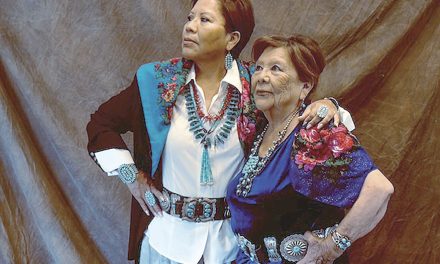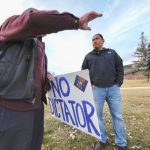
50 years ago: Nakai’s win spells trouble for Times
The ugliest race in the Navajo Nation’s history was finally over and everyone seemed to be glad after all of the media hype about the lies and the name calling, something historians said had never happened at this level before.
It was a bitter race with touches of violence and accusations that the election was going to be rigged. It was, all in all, a race that no one seemed to be proud of.
On the front page of the Nov. 17 issue of the Navajo Times, the banner said it all: NAKAI APPARENT WINNER IN RACE.
The race was so close in many chapters but as of noon Thursday, when that issue of the paper went to press, with 14 chapters still not reporting, the vote for Raymond Nakai was 12,069 while his challenger, Samuel Billison, was at 11,025.
Election officials expected that the total vote would be around 25,000, meaning there were less than 2,000 votes outstanding. To win, Billison would have to get 75 percent of the rest of the vote and no one expected he had a chance of doing that.
One interesting aspect of this race was the voter turnout was expected to be less than the 28,000 who voted in the previous race which indicated, in the minds of some political observers on the reservation, that there were thousands of Navajo voters who did not like either candidate, much less thought they had the ability to lead the tribe in the right direction.
Billison had spent much of the last weeks in his campaign making all kinds of accusations against Nakai, claiming that he was making promises he did not have the ability or desire to carry out. Nakai would do and say anything, said Billison, to get Navajos to vote for him including promising Navajo ranchers that they would be allowed to have as many sheep as they wanted, despite what their grazing permits said.
That’s a promise that a lot of ranchers liked but no one believed, because it was the Bureau of Indian Affairs and not the tribe that had control over the tribal grazing lands and any attempt by Navajo ranchers to increase their sheep population would be met with swift retaliation by BIA officials.
“The pattern of votes for each chairman candidate generally followed predictions concerning areas which they were thought to be strong,” the Times reported.
Nakai swept Shiprock, which everyone expected because of the strong membership of the Native American Church in that area. Billison, on the other hand, took the Checkerboard and Tuba City areas, but, according to the Times, he received nowhere near the level of support in those areas that Nakai did in Shiprock.
But the big result of the election was something the Times did not mention until the following week – eight members of the Old Guard, council delegates who did everything they could to see that none of Nakai’s proposals during his first term was approved by the council, had been voted out and eight men supportive of Nakai were elected in their place.
For the first time, Nakai would actually be given the power to carry out the promises he first made four years before and everyone seemed to be happy that the four years of deadlock was finally over.
The Times reported that the average Navajo voter was tired of reading about all of the internal fights that went on within the tribe and the failure of the council and Nakai to address some of the major issues facing the tribe at that time, including the high rate of unemployment, increased crime and the feeling by many that the BIA had too much control over Navajo affairs.
Nakai had promised and was still promising to do something in those three areas and, for the first time, he would actually be given a chance to do it.
But within the Times, there was a great deal of concern about what steps Nakai would take against the paper.
Throughout his campaign, he had lashed out at the Times, accusing the paper of printing lies about him and pushing Billison for the chairmanship.
Chet Macrorie, who had left the paper in 1964, had come back during the final weeks of the campaign at the request of members of the Old Guard on the council who were afraid that Nakai would take over the paper and use it solely for his benefit.
Macrorie knew his days were numbered because come January he would not have the Old Guard members on the council to protect him.
There was also serious concern that Nakai may do away with the paper altogether and have it revert back to a newsletter as it was in its first two years of operation.
Nakai’s more likely course was to get rid of Macrorie and appoint someone whom he had control over so that for the next four years the paper would stay out of tribal politics and could be used by the administration to get the news out to the people in the way they wanted it to get out.
And while papers in the border communities – especially the Gallup Independent and the Farmington Times – covered events on the reservation, they usually only had one or two stories a week and did not circulate in many areas of the reservation that the Times did.
So a Nakai victory would have a major effect on the Times and it was only a matter of a couple of months before the first snow would fall and the paper would see what Nakai had in store for employees at the Times.
To read the full article, pick up your copy of the Navajo Times at your nearest newsstand Thursday mornings!
Are you a digital subscriber? Read the most recent three weeks of stories by logging in to your online account.








 Highway 264,
Highway 264, I-40, WB @ Winslow
I-40, WB @ Winslow